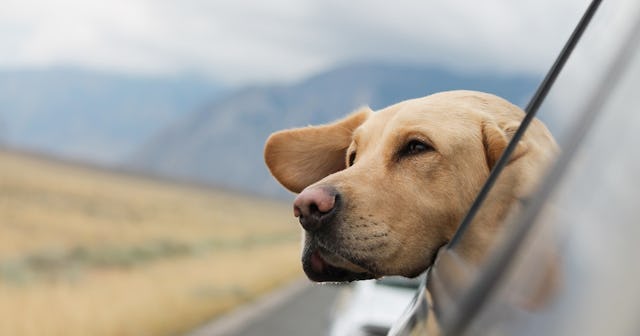Dog Car Sickness Got You Down? How To Keep Your Pup's Nausea At Bay

There is nothing worse than a sick puppy — if only because, just like babies, they can’t tell you what’s wrong with them. And as much as most dogs love hopping in the backseat and going on an adventure, those same car rides can lead to dog car sickness, which is not fun for anyone involved: your pet or the human who has to clean it up (uh, probably you). If this plight sounds familiar, you’re certainly not the only dog owner who likely avoids road-tripping with their pup. According to VCA Hospitals, motion sickness is very common for dogs, especially younger ones.
In fact, you may not even realize your little Muttley Crue is prone to dog car sickness. Because, spoiler, it doesn’t always just involve puppy puke. The symptoms of doggy car sickness can include whining and pacing, excessive drooling, smacking or licking lips, lethargy or inactivity, diarrhea, and yep, vomiting.
If you can, pulling over and taking a quick walk might settle your dog’s stomach. But, for future reference, here’s everything you should know about your pup’s car-induced queasiness.
Why does my dog get car sick?
According to VCA, puppies usually “outgrow” getting car sick after a year or two of their lives. Why are younger dogs more susceptible to motion car sickness? It’s “due to the fact that the parts of the inner ear involved in balance are not fully developed.”
Even if you have an older dog, though, you’re not necessarily in the clear. Grown-up dogs who don’t travel very much (or who basically only get in the car to go to the vet and back) might get anxiety before a car ride, which can also lead to them getting nauseous. So, it’s not exactly car sickness, but the results are all the same.
How do I stop my dog from being sick in the car?
Once your dog is feeling car sick, there isn’t much you can do. But the American Kennel Club does have some tips to make travel a little easier:
- Roll down the windows. Lowering the windows keeps the car well-ventilated, which will help “equalize inside and outside air pressure” in an attempt to prevent nausea.
- Put your pup in the middle back seat. Watching the scenery race by through the side window can make your dog feel woozy (just like a human!). Putting them in the middle back seat ensures they look forward.
- Try car-crating. A solid side crate in the car will limit what your dog can see and help them stay calm.
- Skip the Scooby Snacks. If you’re going on a long trip, withholding food for 12 hours before pulling out of the driveway can also help (though check with your vet if your dog already has dietary issues).
- Bring a comfort item. You can help ease your dog’s anxiety by bringing along their fave toy or blanket.
- Or buy a special car toy. Do yourself a real solid and purchase something your dog only gets in the car so that they start to associate car travel with something fun and good. It’ll make them less nervous.
- Car-train your pup. Working with your dog to be comfier in the car may eliminate anxiety as well. For a few minutes each day, put your pup in the vehicle without turning it on just to acclimate them to their surroundings. (Never leave your pup in a car unattended, though.) After a couple of days, start turning the car on and going for short rides. Even just up and down the driveway will do!
- Offer an end-of-ride reward. If the ride ends with something fun, like a trip to the park or a doggy play date, all the better.
- Use non-toxic calming herbs or oil to put your dog’s stomach at ease. Before loading into the vehicle, douse a few cotton balls in lavender and leave the cotton balls in the car for 30 to 40 minutes.
- Give your dog ginger. A small dose of ginger is great for motion sickness and other gastrointestinal problems if you’re looking for a natural remedy for your pup’s nausea. Humans can also chew on some ginger to help with sickness.
What can I give my dog for car sickness?
Hopefully, the above tips will help to eventually relieve your dog’s anxiety, leading to less nausea and unsettled stomachs overall. But if all else fails, you might want to talk to your vet about getting some medication for your pup before car trips. They may prescribe something for anxiety and nausea or even a sedative to help your dog sleep for the long haul.
Having said that, sedatives can be rough on any animal, so trying to train your dog to be less anxious in vehicles is probably the best first step toward dog-car-sickness-free rides. It would be a shame for your BFF (best furry friend) to miss out on family road trips just because they can’t take being in the car.
What should I do after my dog vomits?
When your pup pukes, there are a few things you can do besides rubbing their tummy to make them feel better. After they throw up, avoid giving them food for the next six hours. When you do feed them, make sure the meals are bland and avoid treats. Keep your dog hydrated by giving them lots of water.
Why is my dog throwing up yellow liquid?
Often dogs throw up what they’ve eaten, but if your pup pukes yellow liquid or foam, it’s usually caused by an empty stomach. The yellow foam is actually created by their liver. It’s kept in the gallbladder and then transferred to the small intestine. So, if your dog gets motion sickness in the car, the yellow puke isn’t caused by anything they’ve eaten.
This article was originally published on